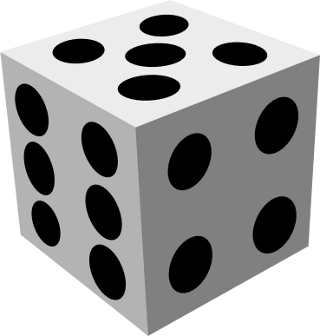 Lara’s sick of playing Monopoly. It’s not so much the game itself but the dice that annoy her. "Why is 12 (double 6s) so hard to get? It’d be so much easier if all totals came up the same number of times."
Lara’s sick of playing Monopoly. It’s not so much the game itself but the dice that annoy her. "Why is 12 (double 6s) so hard to get? It’d be so much easier if all totals came up the same number of times."
Can you design two dice so that first of all only the totals 6 and 12 come up? If so, what is the probability of getting a 6 and a 12 with your dice?
Can you then design two dice so that only 6 and 12 come up and they come up equally often?
Solution
Note that there are many ways to do this problem and it is highly likely that you will come up with quite a different answer from the one we’ve given here.
We first have to put different numbers onto the two dice so that we get totals of 6 and 12 only. Now we can get a 6 in several ways: 1 + 5, 2 + 4, 3 + 3.
Let's try putting a 1 on one dice (call it dice A) and a 5 on the other (dice B).
A = 1, ?, ?, ?, ?, ? B = 5, ?, ?, ?, ?, ?
Now if we put another number on dice A, it has to make 6 or 12 with every number of dice B. So it has to make a 6 or a 12 with 5. This means it can only be a 1 or a 7, let's put some of each
A = 1, 1, 1, 1, 7, 7 B = 5, ?, ?, ?, ?, ?
On the other hand, any other number on dice B has to make a 6 or 12 with a number from dice A. Hence it has to be a 5.
A = 1, 1, 1, 1, 7, 7 B = 5, 5, 5, 5, 5, 5
So now the dice will always give a sum of 6 or 12. Clearly there must be quite a few ways of doing this, given that 6 can be made up in three ways.
Now with the two dice that we have got above, what is the probability of getting 6 and what is the probability of getting 12?
Well, the first thing to notice is that Dice B will always give 5, so the total depends on whether you roll a 1 or a 7 on dice A. There are 4 1s and 2 7s on dice A so you will roll a sum of 6, 4/6 of the time and a sum of 12, 2/6 of the time. To make the sums come up equally often we clearly need to have the same number of 1s and 7s on dice A. The idea is then that we put three 1s and three 7s on dice A.
Extension
How many different dice can you produce that give totals of only 6 and 12?
How many different dice can you produce that give totals of only 6 and 12 and give the totals equally often?